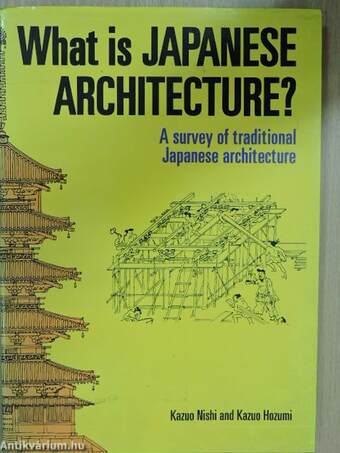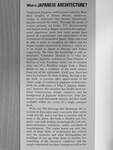1.035.157
kiadvánnyal nyújtjuk Magyarország legnagyobb antikvár könyv-kínálatát

VISSZA
A TETEJÉRE
JAVASLATOKÉszre-
vételek
What is japanese architecture?
A survey of traditional Japanese architecture
| Kiadó: | Kodansha International |
|---|---|
| Kiadás helye: | Tokyo |
| Kiadás éve: | |
| Kötés típusa: | Ragasztott papírkötés |
| Oldalszám: | 144 oldal |
| Sorozatcím: | |
| Kötetszám: | |
| Nyelv: | Angol |
| Méret: | 26 cm x 18 cm |
| ISBN: | 4-7700-1992-0 |
| Megjegyzés: | Fekete-fehér ábrákkal, kihajtható melléklettel. |
naponta értesítjük a beérkező friss
kiadványokról
naponta értesítjük a beérkező friss
kiadványokról
Fülszöveg
What is JAPANESE ARCHITECTURE?
Traditional Japanese architecture—whether Buddhist temples or Shinto shrines, residences, castles, or teahouses—has become increasingly familiar around the world. Through the média of motion pictures, art books, T.V. documentaries and dramas such as Shogun, as well as through per-sonal experience, more and more people have gained an acquaintance and appreciation of the architecture of premodern Japan. Somé may even be able to name or recognize the oldest and the largest wooden structures in existence, which are to be found in Japan at Horyuji and Todaiji respectively. Yet often this knowledge is still ru-dimentary. Confusion abounds as to what dis-tinguishes Japanese architecture from Chinese or Koreán or even Southeast Asian, not to mention what sets off a Buddhist temple from a Shinto shrine or, say, a residence of the tenth century from one of the eighteenth. Until now, there has been no recourse for those seeking, through a sin-gle book, to... Tovább
Fülszöveg
What is JAPANESE ARCHITECTURE?
Traditional Japanese architecture—whether Buddhist temples or Shinto shrines, residences, castles, or teahouses—has become increasingly familiar around the world. Through the média of motion pictures, art books, T.V. documentaries and dramas such as Shogun, as well as through per-sonal experience, more and more people have gained an acquaintance and appreciation of the architecture of premodern Japan. Somé may even be able to name or recognize the oldest and the largest wooden structures in existence, which are to be found in Japan at Horyuji and Todaiji respectively. Yet often this knowledge is still ru-dimentary. Confusion abounds as to what dis-tinguishes Japanese architecture from Chinese or Koreán or even Southeast Asian, not to mention what sets off a Buddhist temple from a Shinto shrine or, say, a residence of the tenth century from one of the eighteenth. Until now, there has been no recourse for those seeking, through a sin-gle book, to increase their appreciation of the whole rangé of traditional Japanese architecture. With the publication of What Is Japanese Architecture•?, however, this situation has finally been rec-tified. Construction, design, carpentry, and the background of Japanese architecture, from pre-history to mid nineteenth century, are here made available within the covers of a single, compact book.
With over 300 drawings that illuminate the es-sentials of discussion more concretely than words could ever do, and a text that is succinct and al-ways to the point, the book is divided into four parts—one each dealing chronologically with reli-gious structures, residences, castles, and places of entertainment. The reader learns not only how each of these fields of architecture has evolved over the centuries and what distinguishes the buildings of one age from those of another, but something of the historical conditions and the people responsible for these changes as well as the Vissza
Témakörök
- Vallás > Egyéb vallások
- Idegennyelv > Idegennyelvű könyvek > Angol > Művészetek > Építészet
- Idegennyelv > Idegennyelvű könyvek > Angol > Vallás > Egyéb
- Művészetek > Építészet > Kontinensek szerint > Ázsia > Távol-Kelet
- Művészetek > Építészet > Idegen nyelv > Angol
- Művészetek > Építészet > Műemlékek > Egyéb
- Művészetek > Építészet > Összefoglalók > Külföldi
- Művészetek > Építészet > Építészettörténet > Külföldi
- Idegennyelv > Idegennyelvű könyvek > Angol > Vallás > Buddhizmus
- Vallás
- Vallás > Buddhizmus
Megvásárolható példányok
Nincs megvásárolható példány
A könyv összes megrendelhető példánya elfogyott. Ha kívánja, előjegyezheti a könyvet, és amint a könyv egy újabb példánya elérhető lesz, értesítjük.











